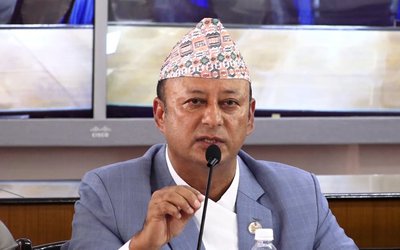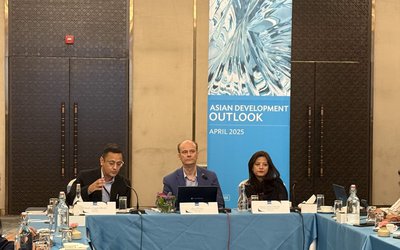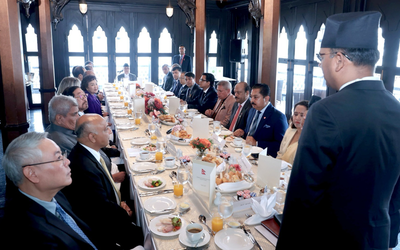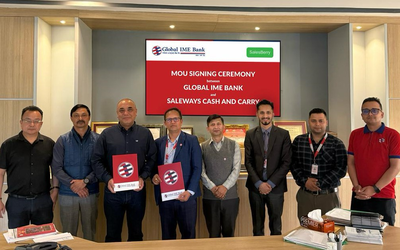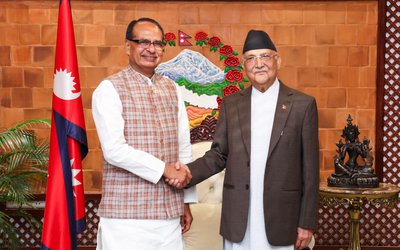
Asian Development Bank (ADB) recently published a report indicating that Nepal needs to have an enabling business environment and political stability to improve its economic performance.
Just a week back, economic indicators published by the Trade Promotion Center showed Nepal's grim economic reality of increasing imports of luxury goods. ADB's Outlook reminded about Nepal's overall economic performance.
“We all agree Nepal has huge potential for growth, but there are also substantial hurdles to overcome in triggering the high growth process,” said Kenichi Yokoyama, ADB’s Country Director for Nepal. “Developing infrastructure bases, particularly power, strengthening institutional capacities, and promoting strategic and proactive policies are urgently needed to improve investor confidence in Nepal.”
According to a press release by Asian Development Bank, Nepal's growth is forecast to slow in FY2013 due to a shortage of fertilizers, poor monsoon, low investor confidence and the lack of a full budget.
In its flagship annual economic publication, Asian Development Outlook 2013 (ADO 2013), released recently, ADB projects Nepal’s gross domestic product (GDP) growth to slow to 3.5% in the fiscal year (FY) 2013 due to a shortage of fertilizers, poor monsoon season, low investor confidence and the lack of a full budget, which is also causing funding shortages for ongoing development activities. The prospects of a lower agriculture harvest, wage pressures, further upward adjustment of administered fuel prices, continued power shortages and other supply-side constraints are expected to push inflation to 10.5% in FY2013.
On the external front, the widening trade deficit and a more moderate remittance growth will likely result in a current account deficit of 0.5% of GDP in FY2013. In FY2012, growth rebounded to 4.6%, boosted by a favorable monsoon and robust services growth despite a slowdown in the industry sector and political uncertainties. Agricultural output grew by about 5.0%, the highest rate in four years, while the high growth in services reflected a pickup in tourism and remittances-backed consumer spending.
Presenting the report, Priyantha Wijayantunga, head, Portfolio Management Unit, ADB said developing Asia's Growth will pick from 6.1 percent in 2012 to 6.6 percent in 2012 and 6.7 percent in 2104. "Developing Asia needs to look beyond economies in the US, Euro area, Japan for growth.”
Chandan Sapkota, associate Economic officer of ADB, said that GDP growth of Nepal is expected to drop in Fiscal Year 2013. "GDP growth in FY 2013 expected to decline due to unfavorable monsoon, shortage of fertilization, low business confidence, lack of full budget and subdued growth in India," said Sapkota. According to him, inflation is expected to increase in FY 2013 and current account surplus to sharply drop to deficit.
With a favorable monsoon, adequate fertilizer supplies, the timely adoption of the full budget, and moderate expansion of remittances, ADO 2013 forecasts GDP growth to rebound to 4.2% in FY2014. Assuming a good harvest and cautious monetary policies, inflation in FY2014 is projected to ease only slightly to 9.0% as most of the underlying pressures of the previous year persist. Furthermore, ADO 2013 projects current account to slide more slowly to a 1.8% deficit in FY2014.
While the recent regulatory and monitoring directives by the Central Bank to deal with banking sector issues are steps in the right direction to handle the sector’s immediate problems, the report says that much more needs to be done if Nepal is to address structural changes required to shield the banking sector and the economy from internal and external shocks. This includes consolidating the financial institutions, ensuring sound corporate governance, strengthening internal project and loan analysis, more effective monitoring and control, and better understanding and monitoring of the activities of cooperatives.
Government expenditures continue to suffer stress from subsidies, including on diesel and liquefied petroleum gas, says the report. Prices should be rationalized, while making provisions to protect the welfare to the poor. The report further says that the FY2014 budget needs timely passage to allow for the revision of tax rates, authorization for domestic borrowing, and provision of funding to accelerate development activities, along with measures to address governance issues.
ADB's Asian Development Outlook (ADO) 2013 estimates that regional economic growth in the Asia Pacific region will pick up to 6.6% in 2013 and reach 6.7% in 2014. This is a distinct improvement on 2012, when growth stood at just over 6%. Consumer prices are expected to rise by 4.0% in 2013 and 4.2% in 2014, up from 3.7% last year.
Leading regional economies are settling into a pattern of more moderate, more sustainable growth, founded on new opportunities nearer to home, including domestic consumption and intra-regional trade. Meanwhile, Asia's contributions to global imbalances—its persistent current account surpluses—are smoothly winding down. Yet, developing Asia's recovery phase remains vulnerable to shocks. Strong capital inflows could feed asset bubbles, for example.
Nepal's Soaring Trade Deficit
Nepal´s trade deficit has been widening at an alarming rate in the recent years, amid limited supply capacity, soaring imports and low exports. Nepal´s exports have lately been suffering due to continuous slowdown in factory outputs caused by perennial problems such as load-shedding and industrial unrest. In the eight-month period, Nepal´s merchandise goods exports rose by a moderate 2.6 percent to Rs 50.22 billion, while total imports shot up by 24 percent to Rs 390.87 billion.
Exports to India, Nepal´s largest trade partner, increased by negligible 0.3 percent to Rs 33.31 billion in the review period, while imports from the southern neighbor grew by a whopping 25.7 percent to Rs 255.79 billion due to rise in demand for petroleum products and food commodities.
Exports of woolen carpet and RMGs fell by 16.9 percent and 22.5 percent, respectively, to Rs 3.43 billion and Rs 2.34 billion during the review period. However, exports of iron and steel products rose by 7.2 percent to Rs 8.04 billion. Exports of lentil also increased by 54.9 percent to Rs 2.37 billion and black cardamom exports rose by 5.8 percent to Rs 2.33 billion during the period. Similarly, exports of yarn dropped by 8.9 percent to Rs 3.7 billion while textile exports increased by 9.1 percent to Rs 3.54 billion in the review period.
Nepal’s top five imported items include petroleum - Rs 69.72 billion, Iron - Rs 39.28 billion, Vehicles - Rs 22.57 billion, Gold - Rs 17.14 billion and Electronics - Rs 16.22 billion Nepal’s top five exports include Iron - Rs 8.04 billion, Yarn - Rs 3.7 billion, Textile - Rs 3.54 billion, Carpet - Rs 3.43 billion, Lentil - 2.36 billion.
In the first seven months of the current fiscal year 2012/13, Nepal´s trade deficit widened to Rs 295.96 billion with share of imports being 88.5 percent of the total trade. Trade deficit rose by 28.9 percent mainly due to surge in imports of petroleum products which is around one and half times higher than total export volume of Rs 44.2 billion during the review period.
- IME GROUP: Expands Into Paper Industry
- Mar 24, 2025
- CPN UML: Instigated By India
- Mar 23, 2025
- ADB’S CHIEF ECONOMIST: Nepal Reduces Poverty
- Mar 11, 2025
- FM DR. DEUBA: A Successful Visit
- Mar 11, 2025
- MD GHISING: Target Of Personal Grudge
- Mar 09, 2025
